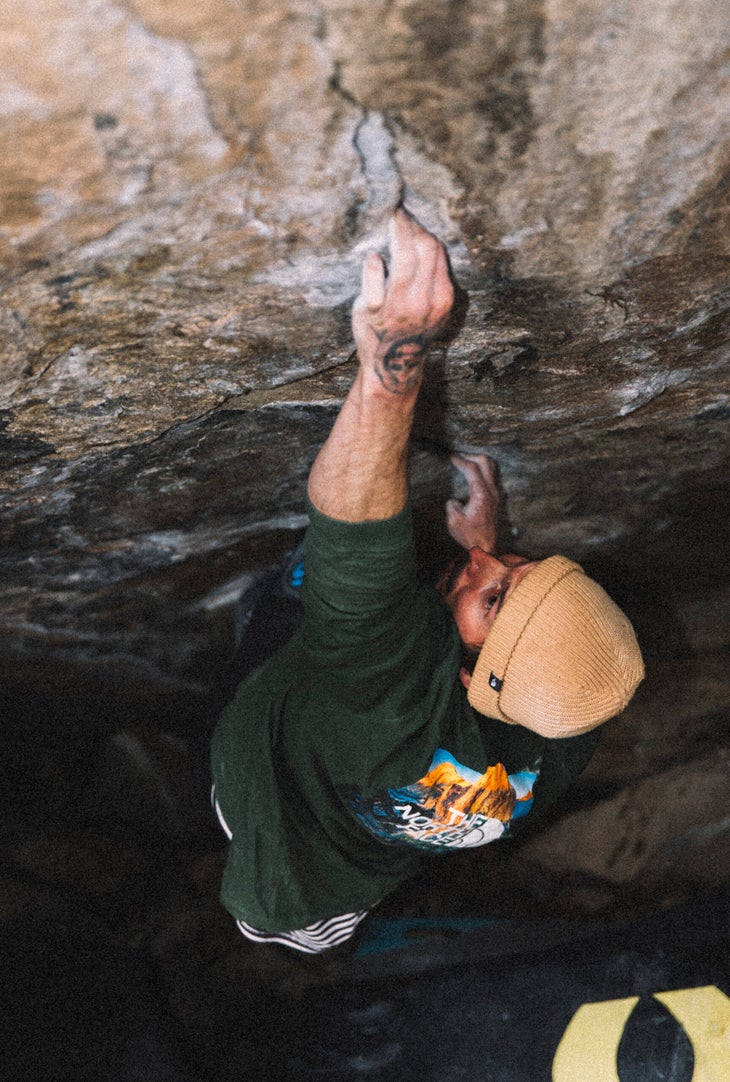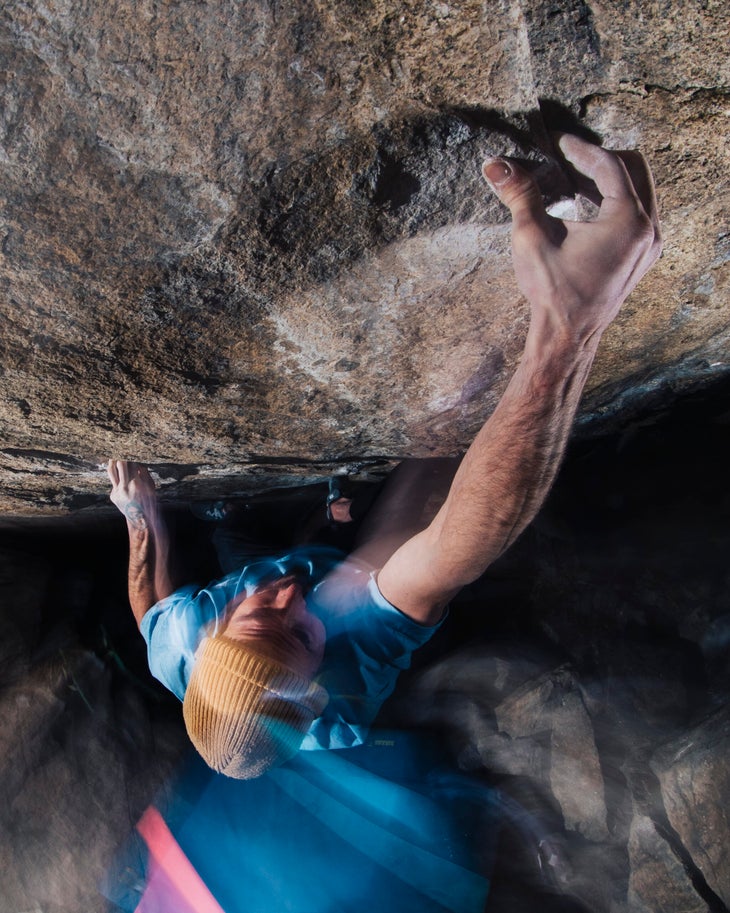Heading out the door? Read this article on the new Outside+ app available now on iOS devices for members! Download the app.
Three years after top-shelf American boulderer Daniel Woods established America’s first V17, Return of the Sleepwalker, he’s back with another hard first ascent. Proposed at low-end V16, Adrenaline entailed as much mental combat as physical.
Named for a high-energy Amelie Lens techno track, Adrenaline consists of ten nail-hard moves to a thank-god jug and a crux sequence involving a painful ringlock and a razor blade edge. From the jug, another 15 feet of mellow climbing leads to the top. Woods estimated the full line is around 30 feet long and 50 degrees overhanging. “It’s kind of weird to break up,” he told Climbing. “The intro is maybe V11 or V12, straight into a five-move V14.”
Woods began working the boulder in Colorado’s Peaceful Valley last year, but it’s been on his radar for nearly a decade. “My friend Chad Greedy showed me the line when I was 26,” he told Climbing. “There were some hefty rocks in the way, so climbing it would have been pretty much impossible. I admired the hold set though, and knew if the rocks were cleared, it would be an impressive challenge.”
Adrenaline took a backseat for Woods until recently when the ever-prolific Drew Ruana dove into the problem, clearing the rocks and opening the line.
With the path open, Woods spent a few days in January 2023 trying to unlock the moves. “Like any new line, the first challenge is figuring out the sequence,” he said. At first he was trying “a heinous method,” but eventually Ruana discovered a good drop knee sequence for the end, and Woods pioneered the ringlock beta leading up to it. “This lock feels secure to reach the edge, which gets you into the drop knee for the final moves,” he said. Unfortunately, that security was totally condition-dependent. “The ringlock is good when it’s cold and skin is tough and dry, but feels horrible when conditions are not good. Also, it is very painful, and my tries on it were limited, but the painful nature of the movement really gets that adrenaline pumping.”
Woods was drawn to Adrenaline for several reasons, particularly the rock quality and hold set—namely the ringlock, which is the hardest he’s found in his career. “I love steep climbing,” he said, “and it is rare to find a pure ringlock hold on a 50-degree roof. It’s cool to have a hard boulder problem with this type of grip.”
In isolation, the ringlock is the obvious crux of the route, “a bit flared and not super secure,” Woods said. “It requires a ton of force on the index finger to work. My finger was constantly bruised. I had to take a lot of days off to heal.” After his January tries, Woods returned to Adrenaline in May, putting in a few days but falling on the drop knee. Conditions soon grew too hot, so he pumped the brakes and waited for winter.

Adrenaline will happen when it’s meant to
Overall, conditions and patience played the biggest role in Woods’s eventual success. Temps needed to be low enough for the ringlock to have the right stick (“I had no chance if my fingers weren’t cold”), but if conditions were too cold, the final, mega-thin razor edge was impossible to grip. “It was a battle of the stick with this one,” Woods joked.
He isn’t sure how many sessions it took to land Adrenaline, noting that he usually stops counting after ten, but he guesses around 25. “Counting the number of sessions is funny to me,” he remarked. “It can take multiple sessions to figure out the right sequence for an FA. Only after you determine your sequence do links start getting made. Luckily, I had Drew there to share beta with, or I would have been stuck trying my heinous method.”
He said that at least half of his sessions were “throw away” because conditions were so bad he “could not do shit on the line, even though my body felt good and I knew exactly what to do. When you can’t stick to the grips there is no chance.”
In light of this, Woods doesn’t feel that the number of sessions a climb requires is a great way of measuring a problem’s difficulty, particularly on problems like Adrenaline. “There are many variables at play when trying to send,” he said. “The most impactful (to me) is weather conditions. This is a variable we cannot control. Tools like a heater and fan help out with this, but in the end, the forecasted weather condition still rules and has a major impact on performance. Also, knowing beta(s) beforehand helps cut the ‘figuring out’ part down. Half the battle with climbing a line is knowing the most efficient sequence. This can take days when trying a line that has never been climbed before. If you’re a climber who is in shape, knows all the beta, and hits a bomb weather window, then a climb will go down pretty quick. Doing an FA is a lot harder than repeating a line.”
Between New Year’s Eve and January 2, Woods fell off the last move three times. “Doing this move in isolation was not bad,” he said, “but my friction from the start made this move into a redpoint crux.” After that, he spent a few sessions unable to clinch the ringlock, which was quite depressing.
“It is weird to go up to a sequence and house it in good conditions,” he added, “then not come close to it when conditions are subpar. I know the reason I am falling is because of stick, but this lowers your confidence, and makes you feel weak.”
Letting this sort of feeling prevail is quite dangerous for a climber, he remarked, and can be a slippery slope into poor performance. Even for a veteran like Woods, staying positive and in the flow is an ever-evolving learning process. “When you lose that strong-feeling sensation on a move or sequence, then you’re in trouble,” he said. “I am learning to not beat myself up over this, and to instead rather recognize ‘why’ I am not succeeding. Once I understand the ‘why,’ I can stay positive and trust myself that the line will happen when it is meant to.”
Ultimately, these factors all came together on February 12. “Skin was fresh, I knew the moves well, my skin texture felt great, and I had a good cold/warm balance in my hands,” he said. “The last move was kind of limit, but everything leading up to that felt perfect. The whole time I knew that when the stick was right I would get it done.”

Woods’s struggle to find the flow
Woods was open on social media about his love/hate relationship with Adrenaline. The problem was addicting and difficult but not particularly enjoyable. He explained to Climbing that although he was captivated by the overall line, hold set, and moves, he hated how painful it was to work. This pain and the reliance on solid conditions made it difficult to get into a flow. “I had limited tries per session,” he said. “I had to take multiple days off between sessions to heal skin and the bone in my finger. I was constantly looking at weather, and trying to decide what day would be best to try (and time of day for prime air temperature and humidity).”
By a certain point, “the pain of the line was making me not have fun anymore,” Woods admitted. “I climb my best when I am having fun. Sometimes, though, you have to find enjoyment in suffering. I knew that when I was standing on top, the feeling would be worth it.”
Ultimately, Adrenaline was more about strategy and mindset than physical prowess, a frustrating reality for Woods. “I guess I did not feel like I was climbing—more waiting for that right moment to execute,” Woods explained. “This is hard for me. Normally I session a lot and can grasp the flow of the moves, which gives me confidence to send. It was challenging for me to do that with this one. I had to be real patient.”
Surprisingly, although he graded Return of the Sleepwalker higher, Woods thought the overall process on Adrenaline was harder. “RotS is physically more difficult, but comfy as hell and fun to climb on,” he said. “You can build fitness and movement memory easier than on Adrenaline.” He said Adrenaline is similar to his 2010 rig Hypnotize Minds (V16). “Both require good conditions, have a finger lock crux, are finger intensive, and have a similar breakdown.”
Still, he found it difficult to propose a grade. On technically harder but non-condition-dependent problems like RotS, “you can attempt the moves and sequences often, which creates a rhythm within the line.” It’s much harder to grade friction-dependent rigs like Adrenaline, “where skin is constantly splitting and you rely on pristine temps and humidity to allow the moves to work,” he said. “These come down to luck for me.”
“I have reached a point in my bouldering where I can look at most hold sets and movement on the hardest boulders out there and know the challenge will not be a physical issue but more of a condition (skin friction) crux. Adrenaline definitely has hard moves, but these moves rely on stick to be executed, so I propose low-end V16 because the start of the climb does not add enough to make it real hard. It adds enough, though, to make the lock move and remaining moves feel harder than when done individually.”
Though younger guns are starting to pop up in the boulder scene, Adrenaline is indisputable proof that Woods remains among the world’s strongest boulderers. He has nearly 40 V15 and harder sends to his name—more than any other climber in history.
Author’s note: Shortly after Woods connected with Climbing, Scottish crusher Will Bosi made the first repeat of Return of the Sleepwalker in 12 sessions, shortly after sending the Jimmy Webb base problem Sleepwalker (V16) and suggesting a downgrade to V15 (also suggested by Zander Waller last fall). “I think it is awesome that he put it together in only 12 sessions!” Woods said in response. “Will is a beast though, and on a mission. He gives me inspiration to continue and push myself.”
